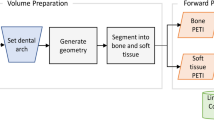Summary
A computed radiograph system (Toshiba, model TCR-201) was used to investigate the digital image analysis of radio-opacity of the paranasal sinuses. The results of the preliminary phantom examination for evaluating the exposure technique indicated that the tube voltage should be kept constant. By using conventional radiographic images and tomographic images of normals and cases of sinusitis, the quantum values (Q-values), Q-value profiles, and Q-value histograms of radio-opacities in the paranasal sinuses were assessed statistically. Findings demonstrated that radio-opacities in the paranasal sinuses could be evaluated quantitatively by these digital image analyses.
Similar content being viewed by others
References
Curtis DJ, Ayella RJ, Whitley J, Moser RP, Rugh KS (1979) Digital radiography in trauma using small-dose exposure. Radiology 132:587–591
Fajardo LL, Hillman BJ, Hunter TB, Claypool HR, Westerman BR, Mockbee B (1987) Excretory urography using computed radiography. Radiology 162:345–351
Goodman LR, Foley WD, Wilson CR, Rimm AA, Lawson TL (1986) Digital and conventional chest images: observer performance with film digital radiography system. Radiology 158: 27–33
Ishigaki T, Sakuma S, Ikeda M (1988) One-shot dual-energy subtraction chest imaging with computed radiography: clinical evaluation of film images. Radiology 168:67–72
Kohda E, Tanaka M, Fujioka M, Miyasaka K (1986) Computed radiography for the major airway in pediatrics. J Jpn Bronchoesophagol Soc 37:393–399
Lams PM, Cocklin ML (1986) Spatial resolution requirements for digital chest radiographs: an ROC study of observer performance in selected cases. Radiology 158:11–19
MacMahon H, Vyborny CJ, Metz CE, Doi K, Sabeti V, Solomon SL (1986) Digital radiography of subtle pulmonary abnormalities: an ROC study of the effect of pixel size on observer performance. Radiology 158:21–26
Pond GD, Seeley GW, Ovitt TW, Chernin MM, Yoshino MT, Roehrig H, McIntyre KE (1989) Intraoperative arteriography: comparison of conventional screen-film with photostimulable imaging plate radiographs. Radiology 170:367–370
Sonoda M, Takano M, Miyahara J, Kato H (1983) Computed radiography utilizing scanning laser stimulated luminescence. Radiology 148:833–838
Suzaki H, Abbey K (1988) Quantitative assessment of radio-opacity in sinusitis: densitometry using the copper-step-wedge system. ORL (Tokyo) 31 [Suppl 7]:748–751
Author information
Authors and Affiliations
Rights and permissions
About this article
Cite this article
Suzaki, H., Abbey, K. & Nomura, Y. Digital image analysis of radio-opacities in the paranasal sinuses using computed radiography. Eur Arch Otorhinolaryngol 248, 326–330 (1991). https://doi.org/10.1007/BF00169022
Received:
Accepted:
Issue Date:
DOI: https://doi.org/10.1007/BF00169022




